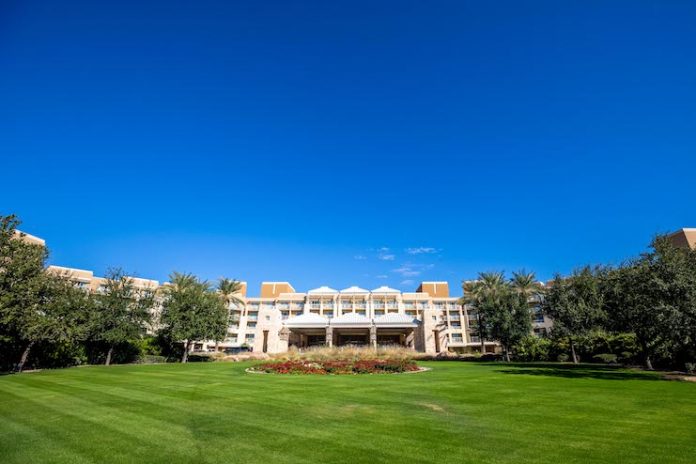
Hundreds of hospitality leaders convened from September 27-30, 2021, at the JW Marriott Phoenix Desert Ridge Resort & Spa for The Lodging Conference—the conference’s first in-person event in two years, having had to cancel the in-person gathering in 2020 amid the global COVID-19 pandemic.
In his welcome remarks during the opening general session on Tuesday, September 28, Harry Javer, founder and producer of The Lodging Conference and president of The Conference Bureau, Inc., pointed to the conference’s registered attendee list of 1,900 as just one example of how the industry has proven its ability to rebound from the crises it faces. Javer noted that the hotel industry is resilient and unified “like no other industry,” especially in times of hardship. “When the chips are down, like they were for the past 18 months, that’s when we really unify,” he said, adding that two organizations, AHLA and AAHOA, served as a foundation for this unity over the past 18 months, advocating for legislation that would support hoteliers and their recovery. “We’re still standing.”
To understand how the industry’s recovery is progressing, industry experts presented data benchmarking and forecasting key performance indicators (KPIs). They also noted the challenges that are impacting the return to pre-pandemic performance levels for many properties, including labor shortages, management-level burnout, and the slow comeback of corporate travel demand.
Overall, the outlook is a positive one—a question of “when,” not “if,” revenue per available room (RevPAR) will return to 2019 levels, said Rachael Rothman, CFA, CBRE’s head of Hotels Research & Data Analytics. Taking a wider view of economic recovery, Rothman noted that GDP has already surpassed pre-pandemic levels and is projected to grow incrementally going forward. However, while GDP is set to grow 11 percent over the next two years, consumer confidence is at a pandemic low, which hampers that economic recovery outlook.
Bernard Baumohl, chief global economist, The Economic Outlook Group, LLC, reviewed his macroeconomic outlook for the U.S. economy. Rising energy prices, supply chain bottlenecks, scarcity of goods, and concerns around the spread of the Delta variant are all factors that are expected to lead to a “fairly significant slowdown” this fall and winter. However, Baumohl noted, “If we can simply look just past this winter and fall, if we can look just beyond the next five to six months, it looks like we’re going to be having a much more normal business cycle, a more normal economic cycle for much of 2022 and certainly into 2023. We see far more positive forces acting on the economy than negative forces when we get into the second half of next year.” This is assuming that the United States does not default on its debt, he added.
His outlook on the return of business travel is likewise optimistic, and he expects more than 90 percent will return over the course of the next year or so. “We’ve been through economic cycles in the past,” Baumohl noted. “Do not underestimate the resilience of business travel to come back. There just is no alternative to have these kinds of interpersonal relationships, meetings, conferences, trade groups, and conventions.”
To benchmark and forecast U.S. hotel industry recovery, Mark V. Lomanno, partner and senior advisor, Kalibri Labs, looked at how close KPIs were to 2019 levels and whether patterns for occupancy, RevPAR, and average daily rate (ADR) mirror those from before the pandemic. For instance, while occupancy has not recovered to 2019 levels, it displayed a pattern in 2020 and 2021 that mirrors 2019’s.
When zooming into weekly data and what that indicates for U.S. hotel recovery, Vail Ross, senior vice president, Global Business Development & Marketing, STR, showed that the RevPAR index came close to 98 percent of 2019 levels, and ADR reached a monthly record-high in July. To keep this trend up in the fall and winter, getting group and corporate business back will be crucial, Ross said, and factors like reopening borders to travel between the United States and Europe, for instance, will help to drive more of that business to U.S. hotels. Ross said that KPIs are forecast to inch closed to 2019 levels next year and will likely get back to pre-pandemic highs in 2023 and 2024.
Katie Moro, vice president, Data Partnerships, Hospitality, Amadeus, shared that based on on-the-books data from about 30,000 hotels, weekly net hotel reservations for future dates are moving in a positive direction and reached a high point over the summer, driven mostly by leisure travel and drive-to destinations. Moro pointed out that while net reservations declined towards the end of August, they began to pick up in September; during the week ending with September 19, 2021, 5 million reservations were made at hotels for future dates compared to the 7 million weekly net reservations made on average pre-pandemic.
To generate more demand and capture a greater share of the market, Moro noted that hoteliers must understand where travelers are making their bookings and the lead time for reserving rooms. The pandemic significantly shifted that channel mix as people increasingly turned to direct channels amid an environment of uncertainty, although on-the-books reservations for 2021 are trending back to a distribution mix that is similar to 2019’s. “There’s strength in Brand.com. It’s a great opportunity to make sure that you’re driving business to your website and getting that direct booking that everyone is looking for,” Moro said.
As occupancy rises, hoteliers continue to face challenges related to hiring and retaining employees, said Del Ross, chief revenue officer, Hotel Effectiveness. According to his company’s labor database, Ross said that the hospitality industry—which pre-pandemic employed 8.3 million direct and indirect, supporting employees—let go of more than 6 million people in April 2020. In the first half of 2021, the industry brought back more than 2.4 million jobs. “From January to July of this year, we hired more people during that time period than we ever hired in a short period of time in our industry’s history,” Ross noted.
The data also showed that in an industry that already has a high turnover rate, attrition has worsened, Ross said, not only among housekeeping and guest services staff but also among salaried employees and managers. “We normally lose about one-third of assistant general managers and managers every year. As of the annualized attrition rate in May and June, we were on pace to lose every single assistant general manager in North America.” While that hasn’t necessarily happened, Ross noted that early in the summer, the industry lost 1 in 12 assistant general managers each month—a pace that improved over the summer in part because those positions were largely unfilled. “This is a big problem for us. We need to be aware of this and we need to make sure that we’re not only investing in recruitment, but that we’re investing in onboarding and training, and that we’re also looking for ways to prevent this. As it turns out, turnover is incredibly predictable: it’s a pretty reliable algorithm of tenure and wage rates.” When planning next year’s budget, Ross added that hoteliers should factor in the return of F&B jobs and hours per occupied room.
In the construction space, new hotel openings in the United States are forecast to grow at a rate of 2 percent in 2021, 2022, and 2023, according to JP Ford, ISHC, senior vice president, director of Global Business Development, Lodging Economics. The first half of 2021 saw 59,000 rooms come online—a “huge number” that the industry hasn’t seen in years, Ford noted. An additional 51,754 rooms are expected to open before the end of the year. By chain scale, the U.S. hotel construction pipeline is strongest for upscale and upper-midscale brands—a trend that has held steady over the past decade—compared to the luxury space, where there is much less development, Ford said.
Adam Lair, MAI, MRICS, managing director, senior partner, HVS, said that while nationally, U.S. hotels are expected to fully recover by 2024, on a submarket and individual property level, recovery will be a “tale of two markets, a tale of two asset classes.” Some markets and properties in the United States have already surpassed their 2019 performance benchmarks, Lair noted, while others have “a lot of runway left to go.”










